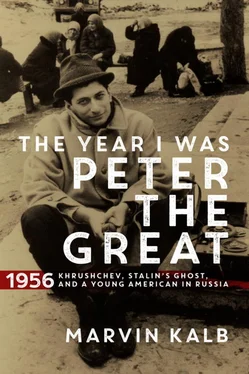In Budapest a huge crowd had gathered in Parliament Square. Hungarian security troops demanded that the crowd disperse. The protesters refused. The troops opened fire and massacred more than 100 demonstrators, wounding many more. Even at a time of spreading violence, when bloodshed was no novelty, this massacre had a stunning impact, inspiring an angry mob to attack Communist Party headquarters, where they seized a handful of officials and, propelled by disappointment and hatred, lynched them by hanging them from city lampposts in downtown Budapest, a scene soon duplicated in other cities. The sight of hanging bodies was the lead item in newsreels around the world, including in Moscow, where Khrushchev now realized that he had to act, that continuing vacillation was an embarrassing symptom of Soviet (and his own) weakness, no longer acceptable in a Kremlin leader privately frightened by the prospect of the disintegration of Russia’s Eastern European empire.
The following morning, on October 31, Khrushchev ordered what amounted to a second Soviet invasion of Hungary, only this time he sanctioned the use of overwhelming force. It was code-named Operation Whirlwind. The Red Army requested, and received, a few days for proper preparation. He also decided to brief his Warsaw Pact allies, all of whom would be affected by the news. He had never briefed them on his de-Stalinization speech, and they had been miffed. He did not want to make the same mistake twice. Accompanied by Molotov and Malenkov, on November 1 Khrushchev flew to Brest, near the Polish-Soviet border, to inform Gomulka, who was not happy about Khrushchev’s decision but could do nothing about it.
The following day the Kremlin troika flew to Bucharest to tell the Romanians and the Czechs about the upcoming invasion, and then they went to Sofia to tell the Bulgarians. No one was happy but no one objected. Finally, Khrushchev and Malenkov flew through a violent thunderstorm to the Adriatic island resort of Brioni to inform Tito of the decision to invade Hungary, a decision the Yugoslav leader initially opposed but then supported.
On November 4 Soviet troops and tanks swooped into Budapest in a vast deployment of seventeen army divisions and crushed the Hungarian Revolution. In a three-column front-page editorial, Pravda explained the invasion, using rhetoric so ugly it would have satisfied the most demanding Kremlin propagandist. “Fascist, counterrevolutionary forces” had tried to control the “putsch,” and “these elements, which are hostile to the people and alien to Marxism-Leninism,” must be eliminated. To attain this goal, “huge concentrations of Soviet troops and forces” had been moved into Hungary “determined” to “crush” the Hungarian “putsch.” There was never any doubt that they would succeed. The Hungarian Army was no match for the Red Army, and it was never in the cards, sympathetic rhetoric aside, that NATO would intervene in this Eastern European crisis. The cost in human life was high: 2,500 Hungarian “freedom fighters” and 700 Soviet troops were killed, most of them on the first day of the assault. More than 200,000 Hungarians fled the country.
The diplomatic cost was also high. The UN spent days denouncing the Soviet invasion, and the White House waved the “Captive Nations Week” banner, suggesting all workers laboring in communist-run countries were slaves and superpower relations could not be improved, despite Soviet protestations about desiring a foreign policy based on “peace, friendship and equality among nations.” President Dwight D. Eisenhower expressed his sympathy for the Hungarian people, but his words lacked conviction. “I feel with the Hungarian people,” he said limply. His secretary of state, John Foster Dulles, issued a statement that simply oozed with hypocritical sympathy. “To all those suffering under communist slavery,” he intoned, “let us say you can count on us.” But except for this lukewarm rhetoric, the United States offered nothing to the Hungarian people, who had expected more than words from the United States.
Just as the Red Army was smashing into Budapest in early November, British, French, and Israeli forces rolled into Egypt, creating a Middle East crisis that forced the suppression of the Hungarian Revolution to share the front page of world newspapers. What happened was that, in an effort to dethrone the Egyptian leader, Gamal Abdel Nasser, and reopen the Suez Canal to international traffic, Israel joined forces with Britain and France in invading the Suez peninsula in a daring operation timed to allow Britain and France to take control of the canal. But before they could complete this controversial and complicated operation, the United States, which had been kept in the dark by its allies, angrily interceded and forced the three invading armies to withdraw immediately, which they did, their plan an embarrassing flop.
Nevertheless, on November 6 the Kremlin plunged into a form of brinksmanship, sending sharply worded warnings to Guy Mollet of France, Anthony Eden of Britain, and David Ben-Gurion of Israel that Russia was prepared to intervene militarily in the Middle East, with or without a UN mandate, hinting at one point that unless the “aggressors” withdrew promptly, which they were starting to do anyway, the Russians would send an untold number of “volunteers” to Egypt. Bulganin then shot off a personal letter to Eisenhower proposing a joint U.S.-Soviet force to accelerate the process, again threatening to demolish the “aggressors” if no action were taken. Foreign Minister Dmitri Shepilov urged the UN Security Council to take immediate action against France and Britain, adding that the Soviet Union would be willing to deploy its forces in such a UN endeavor.
Interestingly, the Kremlin agenda featured another, more immediate but not acknowledged objective—deepening this mood of gloom and doom about a possible big war in the Middle East in order to distract people’s attention from the bloody slaughter of the Hungarian rebels. Russians were much more concerned about the rising casualty rates in Hungary than they were about “Zionist aggression” in Egypt. Moreover, deep down, they did not really believe that Khrushchev was going to send “volunteers” to Egypt. It was not a credible threat, not after their dismal experience in Hungary. No one at JPRS or the embassy thought the Russians would send troops or “volunteers” to Egypt.
But to drum up street-corner enthusiasm for a threat no one seemed to take seriously, the Kremlin resorted to another old propaganda ploy: it staged popular demonstrations in front of the Moscow embassies of the “invaders,” the “aggressors,” the “interventionists”—namely, the Israelis, the British, and the French—demanding an end to their “blatant aggression” in the Middle East. These demonstrations were intended to convey the impression both at home and abroad that the Soviet government was truly angry about the invasion of Egypt and would take drastic action against the “aggressors.” For example, at the Anglo-American School children were sent home early, just to be cautious, even though everyone knew that the demonstrations were phony displays of popular anger. On the day of the demonstrations American embassy personnel were restricted to the compound for three hours, except for those on urgent business, and they needed to be driven in and out of the compound in embassy cars with diplomatic plates.
Pravda described the demonstrations as “spontaneous expressions of public anger,” but in fact they were highly organized and coordinated to begin and end at a certain time. The demonstrators were bused to the embassies and then bused back to their factories, all as part of their day’s work. They carried signs and posters, all painted and prepared on government time. MVD troops stood guard over the demonstrators, the troops and the demonstrators getting tipsy drinking vodka. Few were genuinely antagonistic, and they were mostly gathered at the Israeli embassy, where a door was smashed.
Читать дальше












